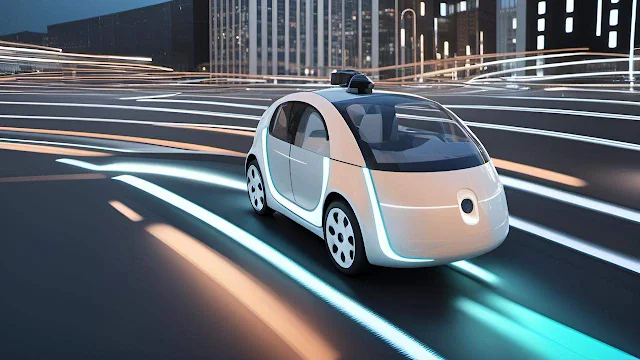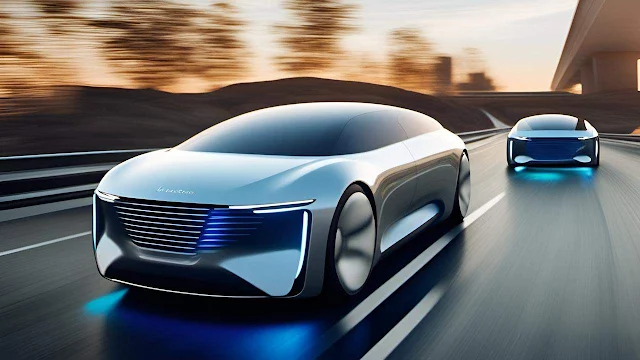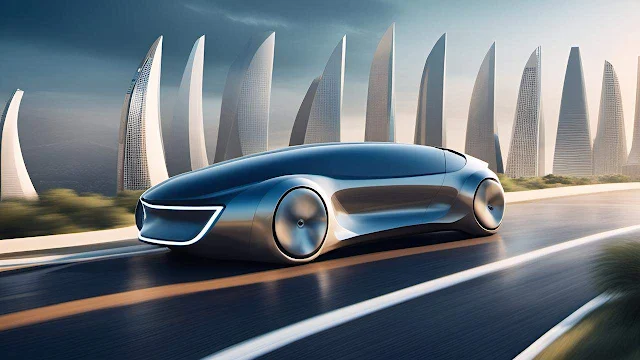Driverless Cars: The Future of Transportation
 |
| A sleek driverless car driving along a road without a human driver - Autonomous vehicles are the future of transportation. |
Get ready for the self-driving revolution! This comprehensive article explores it all - from what autonomous cars are and how they work with sensors and AI, to the timeline for adoption, big-picture benefits like increased safety and mobility access, pressing ethical issues developers must address, questions about jobs and regulation, and profiles of the major players racing to shape the driverless future, including Waymo, GM Cruise, Tesla, and more.
Whether you're curious if these robotic vehicles can handle snow, who's liable in an accident, or when you can buy one, we've got answers. The autonomous era approaches - learn what it means for society.
The concept of driverless cars, also known as autonomous or self-driving cars, has rapidly shifted from a futuristic fantasy to a real-world possibility. Major tech and auto companies have invested heavily in developing the complex technology needed for computer-operated vehicles that fundamentally promise a transportation revolution.
While fully autonomous cars are still a few years away from becoming mainstream, the potential benefits they offer society are immense. From saving lives through safer roads to providing mobility for the elderly and disabled, driverless cars are expected to transform mobility as we know it. However, developers must still overcome several key technical and regulatory hurdles concerning safety and accountability before driverless cars hit the mass consumer market.
What are Driverless Cars?
 |
| Infographic showing driverless car technology like cameras and sensors - Visual and radar sensors allow self-driving cars to perceive their environment. |
A driverless or autonomous car is a robotic vehicle designed to move passengers from one point to another without human input. Instead of a human driver, these cars utilize a combination of sensors, cameras, radar, and artificial intelligence (AI) to navigate and operate the vehicle.
To qualify as fully autonomous, a driverless car must be able to perform all driving functions and monitor road conditions without any human involvement. The Society of Automotive Engineers (SAE) has defined 6 levels of driving automation from Level 0 (no automation) to Level 5 (full automation) to standardize self-driving capabilities.
Key Features of a Driverless Car:
- Sensors like radar, LIDAR, and cameras to detect surroundings.
- Connectivity capabilities like V2V (vehicle-to-vehicle) and V2I (vehicle-to-infrastructure) to share data.
- Highly detailed road maps and GPS for navigation.
- AI and machine learning algorithms to process information and make driving decisions.
- Redundant braking and steering systems to control the vehicle.
- Visual interfaces to communicate with passengers.
Today, most autonomous cars in development are around Level 3-4 automation with some self-driving capabilities but not complete autonomy. Waymo, GM Cruise, Zoox, Argo and Aurora are some of the major companies advancing driverless car technology.
How Do Driverless Cars Work?
Driverless cars are complex robotic systems powered by cutting-edge software, hardware and AI capabilities. Here is an overview of key technologies that enable autonomous driving:
Sensors
Sensors allow the car to “see” and perceive its surroundings. Different types used are:
- Cameras: Provide visual data for navigation, traffic signals/signs, pedestrians, etc.
- Radar: Uses radio waves to detect shape, speed and direction of objects.
- LIDAR: Generates a 3D map of the environment by emitting laser pulses.
- Ultrasonic: Use sound waves to identify close-proximity obstacles.
- Infrared: Detects pedestrians and animals in low light.
The sensor data generates a real-time view of the car’s 360-degree environment for the AI system to process.
Maps and GPS
Pre-generated 3D maps provide in-depth data on roads, lanes, intersections, exits, stop signs, etc. This is combined with GPS and navigation systems to pinpoint the vehicle’s precise real-time location for route planning.
Connectivity
V2V (vehicle-to-vehicle) and V2I (vehicle-to-infrastructure) connections allow autonomous cars to communicate wirelessly with surrounding vehicles, traffic signals, toll booths, and other infrastructure. This data sharing enhances decisions.
Artificial Intelligence
Sophisticated AI processing systems take input from sensors, maps and connectivity to understand the environment. Advanced algorithms then plan and execute the vehicle’s route, speed, maneuvers, responses etc. Machine learning continuously improves the driving intelligence.
Control Systems
These electronically controlled systems convert the AI’s decisions into mechanical operations to drive the car. Redundancies in critical systems like steering and braking enhance safety in case of failures.
This complex technology stack enables autonomous cars to mimic or surpass human driving abilities. Companies are testing and improving the self-driving systems for safety and reliability through billions of miles of road testing.
The Evolution of Driverless Cars
 |
| Waymo self-driving car being tested on public roads - Waymo is a front runner in developing autonomous vehicle technology. |
The roots of today’s autonomous vehicle technology trace back to initiatives by the US Defense Department and major automakers over 50 years ago:
- Early 1970s: Defense Advanced Research Projects Agency (DARPA) funded autonomous vehicle research.
- 1977: Japanese engineers developed first self-driving car with cameras, sensors and computers.
- Late 1990s: Automakers introduced radar-based smart cruise control and other ADAS features.
- 2004: DARPA conducted first long autonomous vehicle route.
- 2009: Google launched its self-driving car project Waymo.
- 2016: Tesla released Autopilot with auto-steering and lane centering.
- 2021: Waymo began offering driverless taxi service in Phoenix.
However, the industry is still working to achieve Level 5 or full autonomy capable in all environments and road conditions. Most experts estimate it will take another 5-10 years to reach this milestone. Ongoing advances in sensor technologies, connectivity, geolocation, and AI/machine learning will enable that vision.
Benefits and Advantages of Autonomous Vehicles
 |
| Driverless car service transporting a disabled passenger - Autonomous vehicles expand mobility access for the elderly and people with disabilities. |
The driverless car revolution aims to be as transformative as the traditional automobile was 100 years ago. Some major benefits include:
Improved Road Safety
It’s estimated over 90% of car accidents today are caused by human errors like distracted, reckless or impaired driving. Self-driving technology follows traffic rules, is always alert, and takes no risky actions. This promises a potential 90% drop in accidents.
Increased Accessibility
For people unable to drive due to age, disabilities or other factors, autonomous cars provide independent mobility. They can also reduce drunk driving. Studies show over 65% of disabled people will have greater community access.
Productivity Gains
Drivers can utilize commute times for work, rest, entertainment instead of focusing on the road. McKinsey estimates people may recover 50 minutes per day, leading to productivity gains.
Efficient Mobility
Optimized routing, smoother flows, and reduced accidents can cut congestion and improve traffic flows. This can reduce commute times by nearly 40% according to Intel. Shared driverless taxis can also reduce car ownership.
Environmental Benefits
Autonomous technology fosters eco-friendly driving behaviors like smooth speed control, less rapid acceleration/deceleration etc. This improves fuel efficiency by 10-20%. Reduced traffic also curtails greenhouse gas emissions.
Enhanced Comfort and Convenience
Passengers can relax or work instead of driving. The car handles safety checks, refueling, parking, drop-offs and pickups. Parents may feel more comfortable sending kids alone in smart cars.
New Business Opportunities
The autonomous vehicle industry promises to be a major economic growth engine and job creator. Emerging business opportunities span vehicle development, manufacturing, maintenance, software, mapping, car sharing, entertainment and more.
Challenges and Concerns Around Driverless Cars
Despite great promise, society must thoughtfully address concerns around safety, ethics, jobs, infrastructure needs and more to incorporate autonomous vehicles.
Technological Limitations
While rapidly improving, sensors still face challenges in poor visibility conditions. AI also struggles in complex unexpected situations with unclear outcomes. More fail-safe testing is required.
Safety and Security Risks
Software failures, hacking and cyber attacks are risks for any internet-connected system. Strict safety protocols and redundancies will be vital. Some accidents in testing have already occurred.
Ethical Dilemmas
Programming autonomous cars to make moral decisions in unavoidable accident scenarios raises ethical issues. What principles guide decisions in scenarios with grave consequences?
Legal and Liability Questions
With shared control between human and machine, who bears responsibility in accidents? New liability and insurance frameworks must emerge to account for this mixed responsibility.
Infrastructure Challenges
Widespread adoption requires major investments in smart transportation infrastructure, such as vehicle-to-everything (V2X) systems, intelligent traffic signals, dedicated lanes, new road signs etc.
Job Losses
Automation of driving could destroy millions of jobs for truckers, cab drivers, couriers etc. However new job opportunities may also open up. Transition assistance may be required.
Privacy and Tracking Concerns
Extensive data collection on people's travel patterns and driving behavior raises privacy issues. Strict regulations will be needed around data usage.
Cost Barriers
The high costs of autonomous vehicles and infrastructure upgrades may delay mainstream adoption. Budgets and partnerships are needed to offset costs where possible.
Overcoming these barriers will require coordinated efforts between automakers, government agencies, policymakers, urban planners, technologists, insurers, and other stakeholders over the next decade.
The Road Ahead: The Future of Driverless Cars
The future autonomous vehicle landscape may evolve gradually in phases, based on factors like technological maturity, adoption readiness, policy frameworks and costs.
Current State
Limited pilot testing of prototype Level 4 vehicles for ridesharing, delivery in select cities. Drivers still required for backup. Companies like Waymo, Motional, Cruise leading the way.
2025-2030
Expanded robotaxi availability but still no widespread private ownership. Regulation allows autonomous operations in limited, geo-fenced areas, or with safety drivers as backup in more complex settings.
2030 and Beyond
Industry experts predict Level 5 vehicles capable of going anywhere could arrive. These are expected to disrupt private car ownership, expand accessible mobility, transform urban planning and more.
But the road to that fully autonomous future still has many twists and turns. Progress may be gradual and uneven across locations based on infrastructure, policy, consumer acceptance and technical challenges. While adoption is accelerating, human-driven vehicles will share the roads for decades.
Major Industry Players Driving Autonomous Vehicle Development
Hundreds of companies are racing to lead the autonomous vehicle revolution. Key players across auto manufacturers, tech firms, and startups include:
Waymo - The Google self-driving project turned subsidiary has driven over 20 million real-world miles. It currently operates an autonomous ride-hailing service in Phoenix.
Cruise Automation - The GM-owned company is testing driverless taxis in San Francisco and received a permit to charge fares. It aims to launch commercial service in 2022.
Argo AI - The Ford-backed startup is developing a Level 4 virtual driver system for ridesharing. It is currently testing in Miami, Austin and Munich.
Zoox - Acquired by Amazon in 2020, the firm is creating an autonomous mobility service with bi-directional vehicles. It aims to launch in Las Vegas and San Francisco by 2025.
Aurora - The startup is working on autonomous trucks, vans and cars in partnership with companies like Uber, Volvo and Toyota. It aims to launch commercial services in late 2023.
Tesla - A pioneer in ADAS technology, it offers a robust semi-autonomous Autopilot system and plans to launch a robotaxi service by 2024. However, critics are skeptical about its claims.
Motional - The Hyundai-Aptiv joint venture is testing autonomous vehicles and partnering with Lyft to provide robotaxis by 2023.
Amazon Zoox, Apple, Baidu, Bosch, Continental, Nvidia, Qualcomm and dozens of other players are all contributing to the autonomous vehicle ecosystem. Partnerships between auto and tech giants continue to grow.
The era of affordable, safe and accessible driverless transportation may arrive within this decade. These leading companies aim to make that vision a reality in the near future.
Frequently Asked Questions About Self-Driving Cars
Q: How safe are autonomous vehicles compared to human drivers?
A: Proponents argue driverless cars have the potential to be much safer by eliminating human errors and flaws. However, the technology is still evolving and some risks exist. Companies claim autonomous mode is 3-5 times safer but more comprehensive data is needed.
Q: Will self-driving cars take away driving jobs?
A: Yes, many professional driving jobs could be at risk. But new jobs may be created in fleet management, maintenance, engineering etc. Transition programs can help re-skill displaced workers.
Q: When will driverless cars become available for consumers?
A: Limited autonomous ridesharing services exist today but private ownership is still 5-10 years away. Affordable models for mainstream use may arrive by 2030 or beyond. Gradual adoption is expected.
Q: How will weather conditions like snow impact autonomous vehicles?
A: Self-driving cars still face challenges in heavy rain, snow, and fog. However, sensor and algorithm improvements are expanding their capabilities in diverse conditions. Operations may be limited at first.
Q: Will autonomous vehicles reduce traffic and emissions?
A: They have the potential to optimize traffic flow, reduce congestion, and lower emissions significantly if adopted widely. But poor planning could also increase traffic volumes.
Q: Who is responsible for accidents involving autonomous cars?
A: It's a complex legal issue. The carmaker, software developer, passenger, human driver (if applicable), and other parties may share responsibility depending on the circumstances. New liability frameworks are needed.
Q: How can governments prepare for driverless cars?
A: Upgrading transportation infrastructure, developing comprehensive regulations, revising zoning policies, planning workforce transitions, and updating traffic laws and signs for smart vehicles.
Q: Will self-driving cars be affordable for the average consumer?
A: Currently vehicles cost over $100k but costs could fall below $25k by 2030s as technology matures. Shared driverless taxi services may be more economical for many users than personal ownership.
Driverless cars stand to revolutionize transportation and mobility for millions globally. But thoughtful policy and planning will be vital for society to harness their benefits while mitigating risks and downsides. Despite some uncertainty around the timeline, our driverless future seems inevitable.







